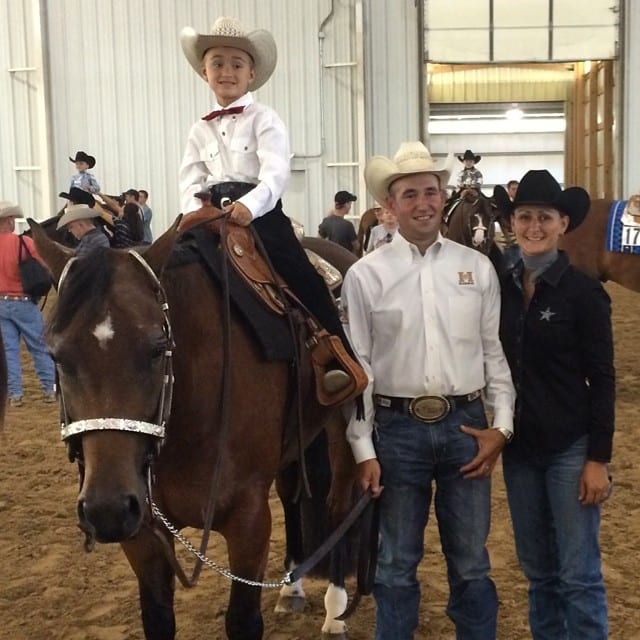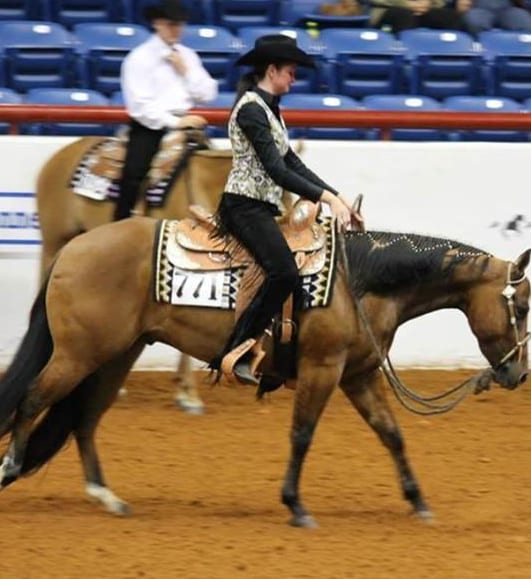The NSBA World Show in Tulsa, Oklahoma is a showcase of multiple breeds competing at the highest level in pleasure and performance classes. With the show over, many would assume that the trainers who attended this event would be relaxing at home after an intense show. However, this is often not the case as most professionals are gearing up to compete in their breed specific World Shows.
GoHorseShow caught up with three successful teams working hard at the NSBA World Show who are just beginning their long fall runs of finales. We were curious to know the difference between the shows, and how trainers prepare and juggle so many shows back-to-back.
QUARTER Million Dollar
 Dawn Baker, wife, mother, and trainer – this busy woman never sits down, unless she is on a horse. And no wonder, as her clients compete at the AQHYA, AQHA and NSBA World Shows, starting the journey in August every year and ending in November. So, it’s not surprising that this hardworking lady was inducted into the NSBA Quarter Million Dollar Club in 2013.
Dawn Baker, wife, mother, and trainer – this busy woman never sits down, unless she is on a horse. And no wonder, as her clients compete at the AQHYA, AQHA and NSBA World Shows, starting the journey in August every year and ending in November. So, it’s not surprising that this hardworking lady was inducted into the NSBA Quarter Million Dollar Club in 2013.
While busy longing a potential AQHA Congress Masters candidate, she talked about the differences in the various World Shows she attends. “For us, the AQHA Youth World is the most stressful, yet very rewarding. Because the clients only have a certain amount of time before they graduate, they strive to attain their goals in a shorter period. This can put stress on them.”
“The AQHA Open World is the polar opposite. It is almost boring,” she laughs. “It is a lot of fun to watch the high-level horses and riders, and often the amateurs are more laid back than the youth kids. The amateurs have no deadline. Most of them are doing this as a hobby, and they are there to have fun as well as compete.”
 “The NSBA World is again very different from the other two. Here, we are showcasing our futurity and young horses. It is so exciting to see the new group of talent emerging. It is challenging to rate and judge how exactly the horses will prepare because they are youngsters. You do not want to tire them out too much or have them be too fresh.”
“The NSBA World is again very different from the other two. Here, we are showcasing our futurity and young horses. It is so exciting to see the new group of talent emerging. It is challenging to rate and judge how exactly the horses will prepare because they are youngsters. You do not want to tire them out too much or have them be too fresh.”
Baker is a multiple AQHA Congress Masters Champion. Incredibly, she won the AQHA Hunter Under Saddle Masters with a two-year-old and the Three Year Old Open Hunter Under Saddle the same year riding full brothers.
Being on the road can be a grueling experience and preparing for such high stakes competition as a World Show is demanding. Baker explains, “The Youth and Open Worlds can be difficult depending on how many horses and riders we bring. We have to prepare by getting everyone ready for their class unlike when it is just us showing in open classes. However, often, we have older, seasoned horses for this, and they may have a class a day, so it balances out. At the NSBA World, we can have six or more classes a day in multiple rings at various ends of the grounds often at the same time. With showing our twos and threes, this can be a juggling act.”
Spot On
 Mackenzie Fallis, a trainer at J Bar S Training, in Whitesboro, Texas attends both the NSBA World Show and the Appaloosa World Show which takes place in Fort Worth, Texas from October 27 to November 4th. Fallis is a three-time Appaloosa World Champion in the Two-Year-Old Western Pleasure. This year, she became an NSBA Reserve World Champion in the All-breed $2500 and Under Rider and Horse Western Pleasure.
Mackenzie Fallis, a trainer at J Bar S Training, in Whitesboro, Texas attends both the NSBA World Show and the Appaloosa World Show which takes place in Fort Worth, Texas from October 27 to November 4th. Fallis is a three-time Appaloosa World Champion in the Two-Year-Old Western Pleasure. This year, she became an NSBA Reserve World Champion in the All-breed $2500 and Under Rider and Horse Western Pleasure.
Busy putting hoof black on a horse before it had to show, Fallis discussed the different worlds, “The two shows are very different. Obviously, there are multiple breeds at the NSBA that we have to compete against. And, although the Appaloosa World is much smaller, the competition is still very tough. Both venues are very nice which we like, however, we do not bring our amateurs to the NSBA. It is where we showcase our young stock instead.”
 Working non-stop, Fallis continues, “Because we bring fewer horses to the NSBA, we prepare a bit different than the ‘Appy’ World. The select few we bring to Tulsa are high-profile youngsters, so we focus on having them prepared for us to show. We ride them usually a couple of times a day. At the Appaloosa World, we take so many we do not have time to ride them multiple times a day, but with the amateurs there, we have to focus on getting the horses ready for them to show.”
Working non-stop, Fallis continues, “Because we bring fewer horses to the NSBA, we prepare a bit different than the ‘Appy’ World. The select few we bring to Tulsa are high-profile youngsters, so we focus on having them prepared for us to show. We ride them usually a couple of times a day. At the Appaloosa World, we take so many we do not have time to ride them multiple times a day, but with the amateurs there, we have to focus on getting the horses ready for them to show.”
Despite her success in the Appaloosa horse industry and the NSBA World, Fallis still gets excited despite the hard, long hours. She explains, “The Appaloosa World is grueling for us as we take so many horses and so many clients. The NSBA is like a mini-Congress. It can kill you despite having fewer horses. I try just to do what I need to do for myself to get that horse ready. We still get up in the middle of the night to practice. The NSBA is the toughest horse show. It is the highest level of competition and such a prestigious event. I still get a thrill out of just coming and watching the horses and riders here. It sure helps me set my goals.”
Paint It Gold
 Tim and Shannon Gillespie of Gillespie Show Horses in Whitesboro, Texas focus their business on paint horses and double registered quarter horses. She describes their busy schedule, “We attend the AJPHA World Show in June/July, the AQHYA World Show in August, the NSBA World Show in August, the APHA Open/Amateur World Show, which is in September for the first time this year, and we will be attending the AQHA Open/Amateur World for the first time in November.”
Tim and Shannon Gillespie of Gillespie Show Horses in Whitesboro, Texas focus their business on paint horses and double registered quarter horses. She describes their busy schedule, “We attend the AJPHA World Show in June/July, the AQHYA World Show in August, the NSBA World Show in August, the APHA Open/Amateur World Show, which is in September for the first time this year, and we will be attending the AQHA Open/Amateur World for the first time in November.”
Both Tim and Shannon have combined World Championship titles in APHA and NSBA. “There are vast differences in the shows. Obviously, the Youth World Shows have a big focus on the kids, with usually older, all-around type horses competing. There is a focus on patterns, with hours of schooling involved. To contrast, the NSBA World and APHA Fall World have more events and opportunities for the younger, futurity horses that focus on the rail events. While we also take all-around horses to these shows, we find our time and focus to be more consumed with making sure the young horses are properly prepared and cared for.”
 Being prepared and organized is the only way the Gillespies know to stay on top of the multiple world shows, multiple events, multiple horses and multiple clients. She explains, “At the NSBA and APHA Open World Show, we do have to balance young rail horses and all-around horses. This can get tricky, and become grueling. We are schooling patterns, and trying to take the time to prepare young, green horses for high profile futurities.”
Being prepared and organized is the only way the Gillespies know to stay on top of the multiple world shows, multiple events, multiple horses and multiple clients. She explains, “At the NSBA and APHA Open World Show, we do have to balance young rail horses and all-around horses. This can get tricky, and become grueling. We are schooling patterns, and trying to take the time to prepare young, green horses for high profile futurities.”
Gillespie adds, “We try to handle this by having a concrete plan for every horse each day of the event. It’s hard, and it creates sleepless nights, but it is so worth it when it all comes together. World shows with multiple arenas going at once also pose a whole new set of logistical challenges. We do our best to stick to a well thought-out daily plan. It is helpful to have good assistants to keep everything rolling.”
About the Author: Maureen (Mo) West grew up on a large vegetable farm in rural Ontario, Canada where she began riding and showing quarter horses as a child. A former high school English teacher, she gave up that career to attain her dream of training and showing quarter horses professionally. Currently living in Alamo, California she is an assistant trainer at Busick Quarter Horses. She is constantly with her beloved dog, Crash, and enjoys running and fishing in her spare time.








